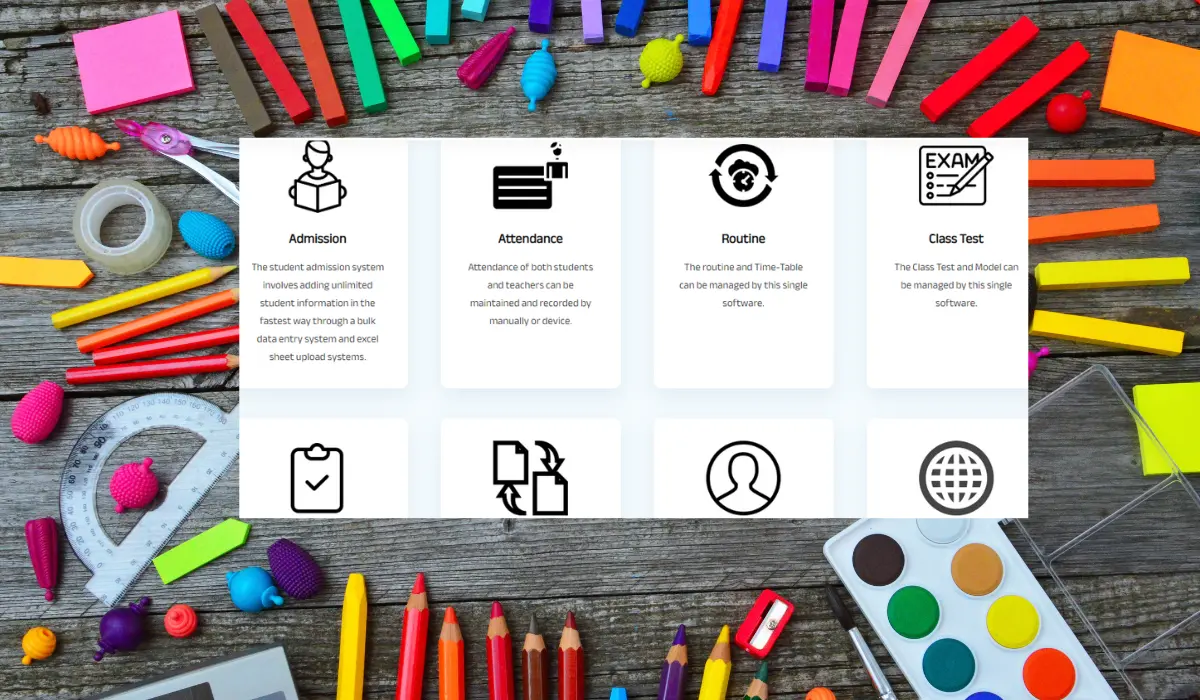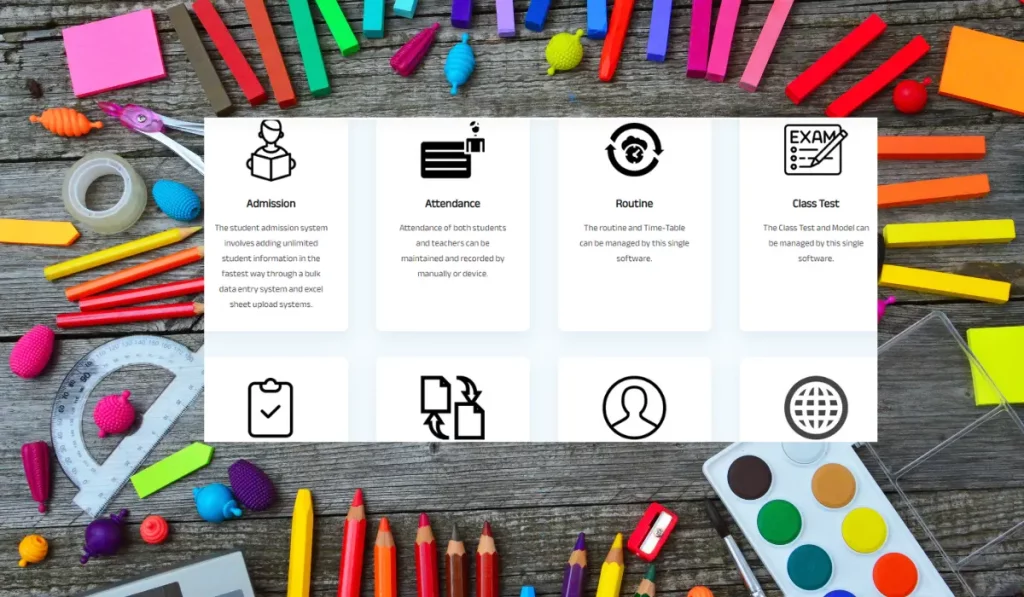In this modern era almost, every school uses school management software. It makes the school administration’s life easy. It helps to organize school work easily and smoothly. In this context, we will talk about the key features of school management software.
Let’s jump into the deep:
Things to know about school management software
School management software, also known as school administration software or student information system (SIS), is a computerized tool designed to streamline and automate various administrative tasks in educational institutions. It helps schools and other educational organizations manage their day-to-day operations more efficiently.
The different school needs different facilities. That’s why all school management software has the customizable facility.
These software solutions aim to improve efficiency, reduce paperwork, enhance communication, and provide a centralized platform for managing various administrative tasks within educational institutions.
Key Features of School Management Software
Here are the key features of school management software that most schools need
Student Information Management:
Centralized Database: The software maintains a comprehensive database of student information, including personal details, contact information, emergency contacts, and medical records.
Attendance Tracking: It automates the process of recording student attendance, generates attendance reports, and alerts parents about their child’s attendance.
Performance Tracking: The software tracks students’ academic performance, including grades, assignments, exams, and progress reports.
Discipline Records: These allow administrators to record and manage disciplinary actions and incidents involving students.
Individual Profiles: Each student has a dedicated profile that includes their academic history, achievements, and any relevant notes or remarks.
Enrollment and Admissions:
Application Management: The software streamlines the admissions process, allowing administrators to manage applications, track their status, and communicate with applicants.
Enrollment Management: It simplifies the process of enrolling accepted students, generating enrollment contracts, and collecting necessary information.
Document Management: The software facilitates the collection and management of necessary documents, such as birth certificates, transcripts, and medical forms.
Attendance Tracking:
Automated Attendance: The software automates the process of taking attendance, either through manual input or by integrating with biometric systems or student ID cards.
Real-time Monitoring: It allows teachers and administrators to monitor attendance in real-time and identify patterns of absenteeism.
Absentee Notifications: Parents can receive automated notifications via email or SMS when their child is absent or late to school.
Attendance Reports: The software generates detailed attendance reports for individual students, classes, or the entire school.
Grading and Transcripts:
Grading System: The software supports customizable grading scales, calculates GPA, and allows teachers to record grades for various assessments.
Report Cards: It generates report cards and progress reports based on the grading data, providing a summary of student performance and areas of improvement.
Transcripts: The software assists in creating official transcripts that document a student’s academic history, courses taken, and grades earned.
Timetable and Scheduling:
Class Scheduling: The software helps in creating and managing class schedules, assigning teachers, rooms, and subjects to specific time slots.
Resource Allocation: It optimizes the allocation of resources such as classrooms, laboratories, and equipment.
Personalized Timetables: Students and teachers can access personalized timetables that show their daily schedule and any changes or updates.
Communication and Collaboration:
Parent Portals: The software provides a dedicated portal for parents to access their child’s information, communicate with teachers, view progress reports, and receive announcements.
Messaging Systems: It enables communication between teachers, administrators, students, and parents through integrated messaging systems or email notifications.
Event Calendars: The software displays school events, holidays, and important dates, allowing stakeholders to stay informed and plan accordingly.
Finance and Billing:
Fee Management: The software helps in managing student fees, creating invoices, and tracking payment status.
Financial Reporting: It generates financial reports, including income statements, balance sheets, and fee collection summaries.
Scholarship and Financial Aid Management: The software facilitates the management of scholarships, grants, and financial aid programs.
Library Management:
Cataloging and Classification: The software assists in organizing and cataloging library resources, including books, magazines, and digital media.
Book Loans and Returns: It automates the process of borrowing and returning books, tracks overdue books, and generates reminders for borrowers.
Inventory Management: The software helps in managing the library inventory, tracking the availability of resources, and generating reports on resource usage
Importance of School Management Software
School management software plays a crucial role in improving efficiency, organization, and communication within educational institutions. Here are the key reasons why school management software is important:
Streamlined Administrative Tasks:
School management software automates various administrative tasks, such as student enrollment, attendance tracking, grading, and report generation. This reduces the manual workload for administrators and teachers, saving time and effort.
Centralized Information Management:
The software provides a centralized database to store and manage student information, academic records, attendance data, and other important details. This ensures that all relevant information is readily accessible and eliminates the need for maintaining multiple paper-based records.
Improved Communication and Collaboration:
School management software facilitates effective communication and collaboration among teachers, students, parents, and administrators. Features like messaging systems, parent portals, and event calendars enable timely communication, sharing of essential updates, and fostering of parent-teacher engagement.
Enhanced Parent Engagement:
Parents can access the software’s parent portal to monitor their child’s progress, view attendance records, check exam results, and communicate with teachers. This promotes transparency, strengthens the parent-school relationship, and allows parents to actively participate in their child’s education.
Accurate Attendance Tracking:
Automated attendance tracking minimizes errors and provides accurate records of student attendance. It helps identify patterns of absenteeism, enables timely interventions, and ensures compliance with attendance regulations.
Efficient Academic Management:
School management software aids in managing academic processes such as class scheduling, grading, and generating report cards. It simplifies the task of teachers, reduces paperwork, and ensures consistent and standardized evaluation and reporting.
Financial Management and Transparency:
The software streamlines fee management tracks payments, and generates financial reports. It helps maintain transparency in financial transactions, simplifies billing processes, and ensures accurate financial records.
Data Analysis and Reporting:
School management software provides analytical tools to generate various reports and insights regarding student performance, attendance trends, financial data, and other metrics. This helps administrators and educators make data-driven decisions and identify areas for improvement.
Increased Security and Data Privacy:
School management software enhances data security and privacy by storing student information in a secure digital system. Access controls and user permissions ensure that sensitive information is only accessible to authorized personnel.
Support for Online Learning:
Many school management software solutions now include features to support online learning, virtual classrooms, assignment submission, and online assessments. This has become especially valuable during times of remote or hybrid learning.
End Words
Overall, school management software optimizes administrative processes, promotes efficient communication, and provides valuable insights to enhance the overall management and performance of educational institutions. It improves collaboration, increases parent engagement, and allows educators to focus more on teaching and student development.
Read More Article






